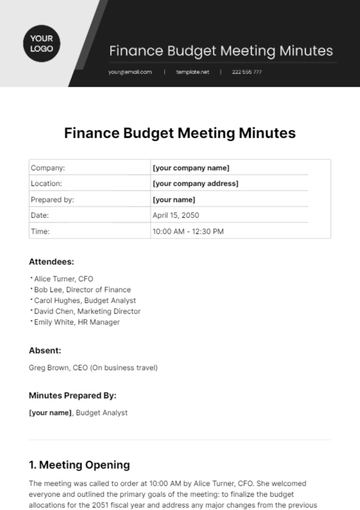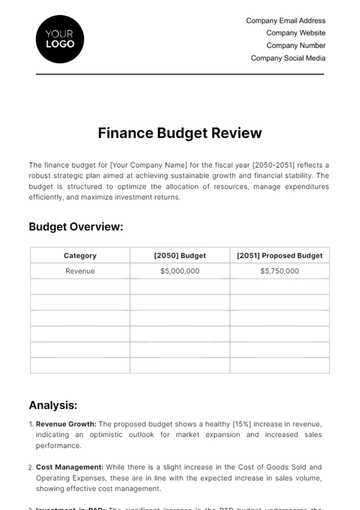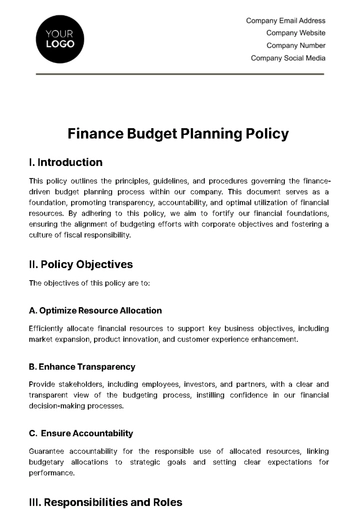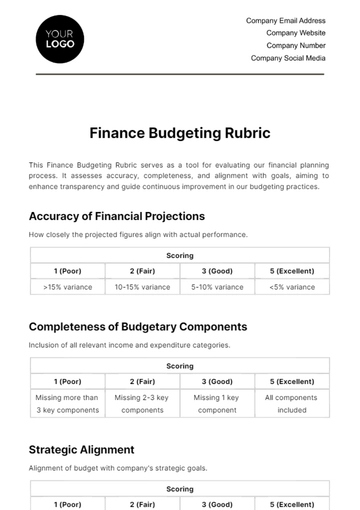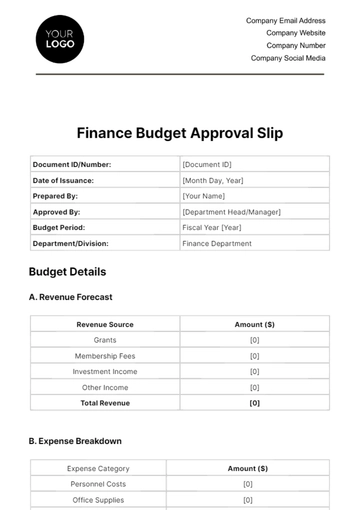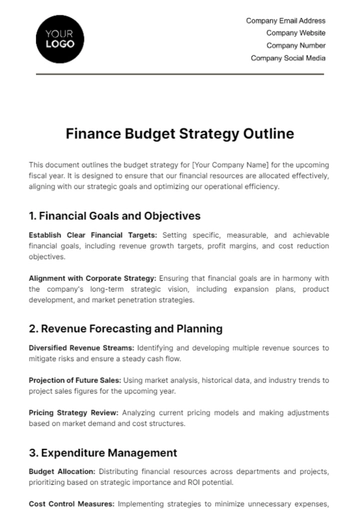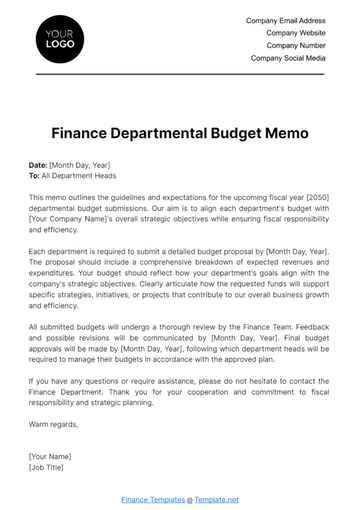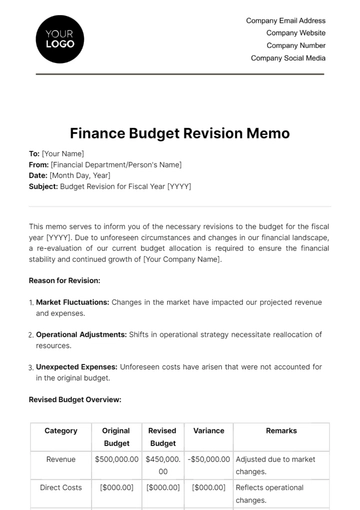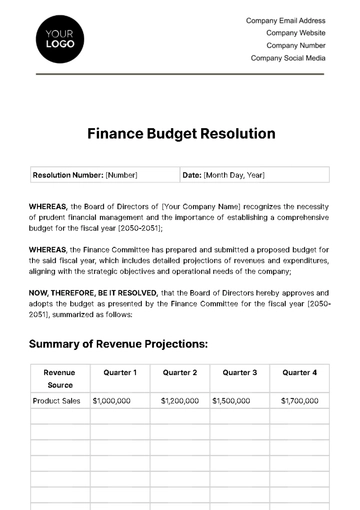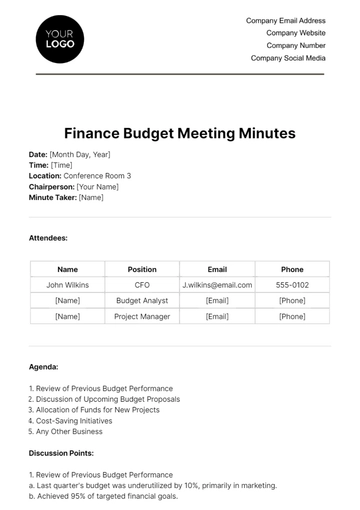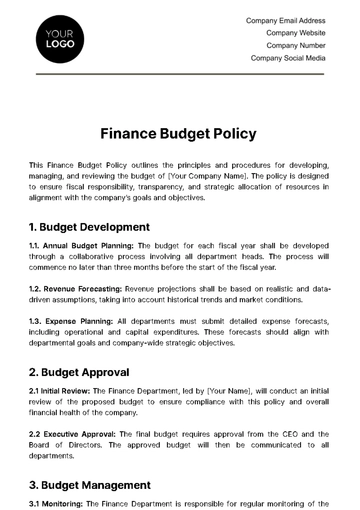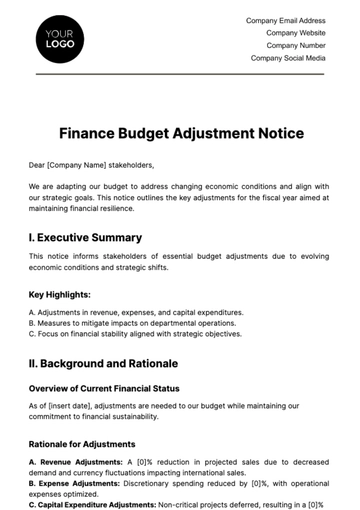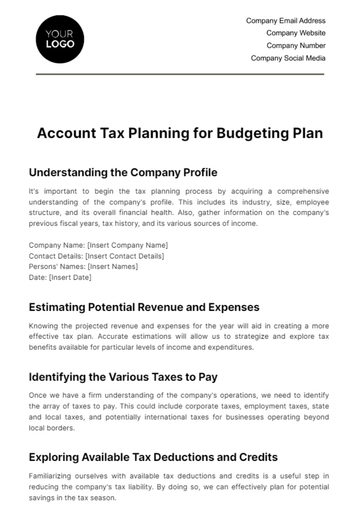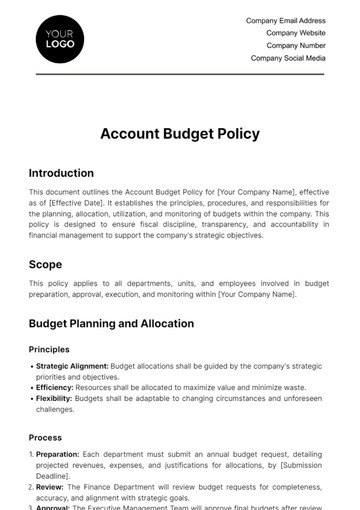Free Finance Budget Crisis Management Protocol
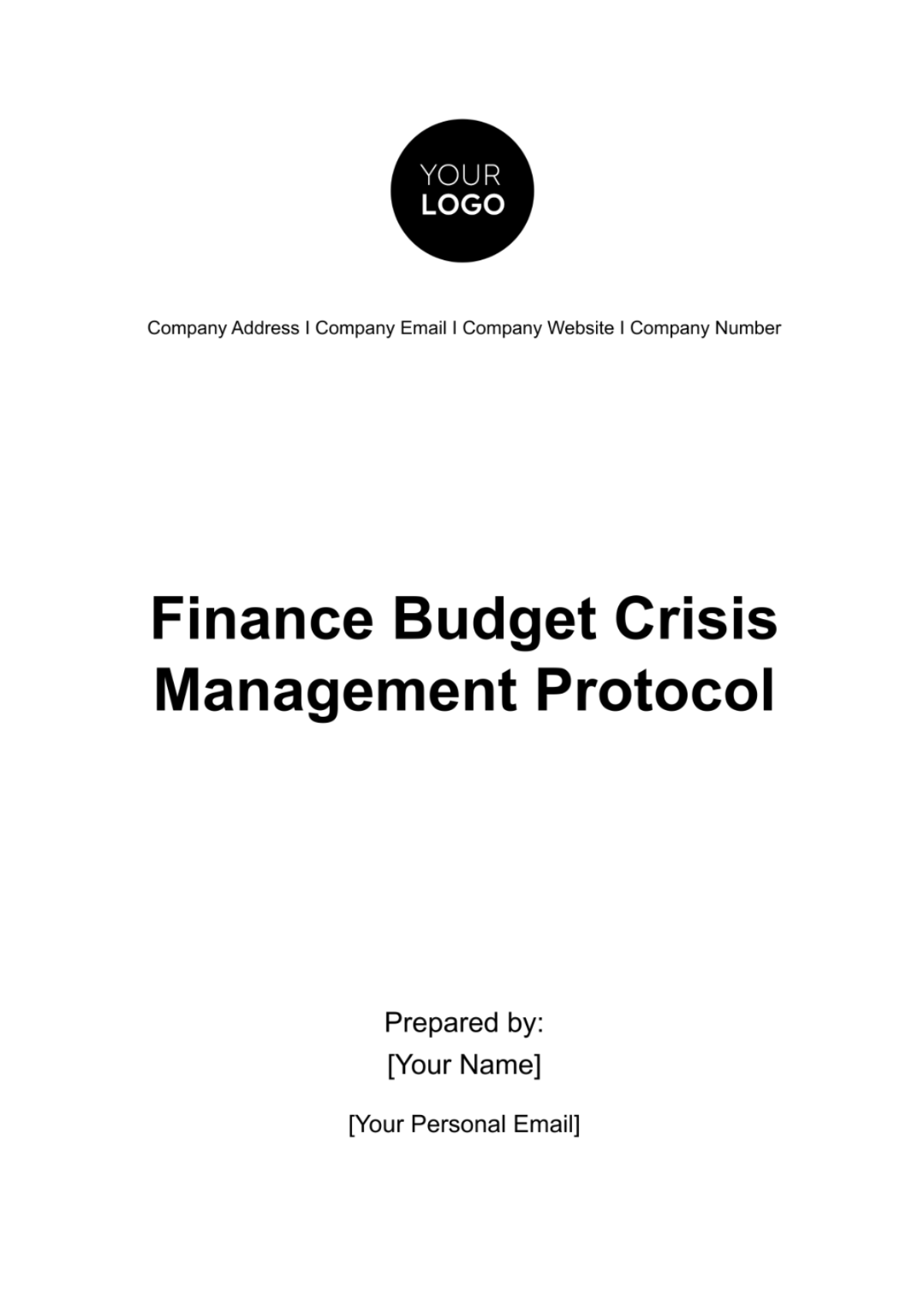
TABLE OF CONTENTS
I. Crisis Identification and Assessment
II. Crisis Response Team Formation
A. Team Composition
B. Communication Channels
III. Financial Contingency Planning
A. Emergency Budget Adjustments
B. Resource Reallocation
IV. Stakeholder Communication and Management
A. Internal Communication
B. External Communication
V. Monitoring, Review, and Recovery Planning
A. Performance Monitoring
B. Regular Reviews and Adjustments
C. Recovery Planning
I. Crisis Identification and Assessment
The initiation of our crisis management protocol focuses on vigilantly identifying early warning signs of a financial crisis. These red flags are crucial indicators that can prelude financial turmoil if not addressed promptly. Signs include a noticeable decline in cash flow, which could signal issues in revenue generation or collection processes.
Abrupt downturns in market demand may indicate shifting consumer preferences or increased competition, necessitating quick strategic adjustments. Unexpected large-scale expenses, such as sudden regulatory fines or unforeseen operational costs, can also strain financial resources.
Moreover, significant industry shifts, like new regulations or disruptive technological advancements, can rapidly change the business landscape. Constant monitoring of these signs, coupled with a thorough analysis of key financial metrics like profit margins, liquidity ratios, and debt-to-equity ratios, is critical.
Initial Assessment
Once early signs of a financial crisis are detected, an immediate and thorough initial assessment is conducted. This crucial step involves a deep dive into the company's financial health, examining detailed financial statements, reviewing cash flow projections, and analyzing prevailing market trends. This assessment is not merely a financial review but a comprehensive evaluation of the company's overall financial stability.
The objective is to gauge the severity of the looming crisis and understand how it could potentially affect various aspects of the business. This includes assessing risks to operational continuity, evaluating the impact on workforce morale and productivity, and determining potential repercussions on customer relationships and market position. By accurately assessing the magnitude and scope of the crisis, the company can formulate a more targeted and effective response strategy, thereby mitigating the risks and setting the stage for a more resilient recovery.
II. Crisis Response Team Formation
Forming a Crisis Response Team (CRT) is a pivotal step in our Finance Budget Crisis Management Protocol. This team, composed of key figures within [Your Company Name], is tasked with spearheading the crisis management efforts. A well-defined team composition and established communication channels are essential for effective crisis management.
A. Team Composition
A dedicated Crisis Response Team (CRT) is formed, comprising key personnel such as the CFO, department heads, and legal advisors. Each member is assigned specific roles and responsibilities, ensuring a comprehensive approach to managing the crisis. The CRT is responsible for strategizing, implementing, and overseeing the crisis management efforts.
Role | Responsibilities | Member |
Chief Financial Officer (CFO) | Oversees financial strategies, manages budget adjustments, and liaises with financial stakeholders. | [Name] |
Head of Operations | Coordinates operational adjustments, ensures business continuity, and oversees supply chain management. | [Name] |
Legal Advisor | Provides legal guidance, ensures compliance, and manages legal risks associated with the crisis. | [Name] |
Head of Human Resources | Manages workforce-related issues, communicates with employees, and implements staff welfare measures. | [Name] |
Head of Marketing and Communications | Leads external communication strategy, manages media relations, and oversees internal communications. | [Name] |
B. Communication Channels
Effective communication channels are established for the CRT, facilitating prompt and clear communication both internally and externally. This includes regular meetings, updates to the entire organization, and designated channels for external communication with stakeholders.
Channel | Purpose | Frequency/Details |
Regular CRT Meetings | To strategize, review progress, and make decisions. | Weekly/Bi-weekly |
Email Updates | To communicate ongoing developments and actions to employees. | As needed |
Dedicated Intranet Page | To provide a central repository of information and updates for staff. | Continuous updates |
Stakeholder Briefings | To keep external stakeholders informed (investors, partners, etc.). | Regular intervals |
Press Releases/Media Communication | To manage public relations and disseminate information to the broader audience. | As required |
III. Financial Contingency Planning
In this section, we focus on developing robust financial contingency plans. These plans are designed to swiftly adjust the budget in response to a crisis and reallocate resources to ensure the company's stability and long-term recovery.
A. Emergency Budget Adjustments
When a financial crisis hits, immediate and decisive budget adjustments become paramount. The first step involves freezing all non-essential expenditures, such as postponing planned expansions or cutting back on discretionary spending. This action is crucial to conserve cash flow, which is the lifeblood of the company during a crisis.
Simultaneously, we focus on identifying and implementing cost-saving measures, such as renegotiating contracts or streamlining operations, to further reduce financial strain. The emergency budget is carefully crafted to maintain core business functions while reducing financial bleed. This reactive approach is designed to stabilize the company’s finances, providing a solid foundation to weather the storm of the crisis.
B. Resource Reallocation
Strategic resource reallocation is crucial for maintaining operational continuity and facilitating recovery. This involves a thorough analysis of all business areas to identify those critical to the company's immediate survival and long-term health. Resources, including finances, personnel, and materials, are then redirected to these key areas. This may require tough decisions, such as reducing funding for less critical projects or temporarily downsizing certain departments.
Additionally, securing new lines of credit or liquidating non-essential assets may be necessary to bolster cash reserves. These actions ensure that the most vital parts of the business receive the support they need during the crisis, positioning the company for a robust recovery once the situation stabilizes.
IV. Stakeholder Communication and Management
Effective communication is critical in crisis management. This section outlines strategic approaches for both internal and external communications, ensuring all stakeholders of [Your Company Name] are appropriately informed, engaged, and supported throughout the crisis.
A. Internal Communication
A clear and consistent internal communication strategy is implemented to keep employees informed about the crisis and the company's response. This fosters a sense of transparency, reduces uncertainty, and maintains morale.
Strategy | Objective | Implementation Method | Frequency |
Regular Updates | To keep employees informed about the crisis response actions. | Email bulletins, intranet posts. | Weekly or as needed |
Virtual Town Hall Meetings | To address concerns and foster a sense of community. | Online conferencing tools. | Monthly |
Direct Team Briefings | To provide specific instructions and support to individual teams. | Meetings led by team leaders. | Bi-weekly |
Q&A Sessions | To address employee queries and dispel rumors. | Scheduled sessions with senior management | As needed |
Feedback Mechanisms | To gather employee input and concerns. | Online surveys, suggestion boxes. | Continuous |
B. External Communication
Guidelines for external communication involve regularly updating investors, creditors, and customers about the company’s status and response actions. Maintaining open lines of communication with external stakeholders is crucial to preserve trust and support.
Guideline | Objective | Method | Frequency |
Transparency | To maintain trust and credibility with external stakeholders. | Press releases, official statements. | As needed |
Consistent Messaging | To ensure a unified and clear message is conveyed. | Pre-approved messaging templates. | Throughout crisis |
Investor Communications | To keep investors informed about financial status and actions. | Regular financial updates, investor calls. | Regular intervals |
Customer Notifications | To update customers on how the crisis affects services/products. | Email updates, social media posts | As needed |
Media Engagement | To manage public perception and provide accurate information. | Press conferences, media interviews. | As required |
V. Monitoring, Review, and Recovery Planning
Critical to the success of our Finance Budget Crisis Management Protocol is the ongoing monitoring, regular review, and strategic planning for recovery. This section focuses on ensuring that [Your Company Name] not only navigates the crisis effectively but also emerges stronger, with robust plans for future stability and growth.
A. Performance Monitoring
To effectively navigate through the financial crisis, [Your Company Name] has implemented a comprehensive system for continuous performance monitoring. This system tracks key financial metrics such as cash flow, profit margins, expenditure rates, and revenue generation in real-time. These indicators provide crucial insights into the health of our business and the impact of our crisis response measures.
By closely monitoring these metrics, we can quickly identify trends, anticipate potential issues, and respond proactively. This vigilant approach ensures that our response strategies are data-driven and aligned with the company's immediate financial needs, enabling us to maintain a stable financial footing even in turbulent times.
B. Regular Reviews and Adjustments
The Crisis Response Team (CRT) at [Your Company Name] conducts regular reviews of our crisis management strategy. These reviews are scheduled bi-weekly and are pivotal in evaluating the effectiveness of our current response measures. During these sessions, the CRT analyzes financial data, assesses the current market situation, and gathers feedback from various departments.
This comprehensive review allows us to identify areas where adjustments are needed, whether it's reallocating resources, modifying budget allocations, or shifting strategic focus. By maintaining this cycle of regular reviews and adjustments, we ensure that our crisis management strategy remains dynamic, responsive, and effective, adapting to changing circumstances and evolving challenges.
C. Recovery Planning
As we navigate through the crisis, our focus also extends to planning for recovery and post-crisis growth. The recovery planning phase involves developing strategies to restore normal business operations, rebuild financial reserves, and re-align the company with its long-term growth trajectories. This includes revising and updating long-term financial plans, exploring new market opportunities, and implementing lessons learned from the crisis to strengthen our financial resilience.
Recovery planning is not just about returning to pre-crisis conditions; it’s about leveraging the crisis experience to emerge as a more robust, agile, and forward-thinking organization. We aim to establish a foundation for sustainable growth, ensuring that [Your Company Name] is well-positioned to capitalize on future opportunities and mitigate risks effectively.
- 100% Customizable, free editor
- Access 1 Million+ Templates, photo’s & graphics
- Download or share as a template
- Click and replace photos, graphics, text, backgrounds
- Resize, crop, AI write & more
- Access advanced editor
Master your fiscal turmoil with Template.net's Finance Budget Crisis Management Protocol. This editable, fully customizable template, editable in our Ai Editor Tool, eases budgetary woes, fostering financial stability. Its professional design offers an engaging and compelling response to fiscal crises. Enable successful financial recovery, use Template.net's template today.
You may also like
- Budget Sheet
- Personal Budget
- Non Profit Budget
- Monthly Budget
- Project Budget
- HR Budget
- Company Budget
- Home Budget
- Weekly Budget
- College Budget
- Business Budget
- Construction Budget
- Small Business Budget
- Hotel Budget
- Annual Budget
- Home Renovation Budget
- Household Budget
- Student Budget
- Grocery Budget
- Marketing Budget
- Corporate Budget
- Startup Budget
- Manufacturing Budget
- Church Budget
- University Budget
- Annual Budget Plan
- Event Budget
- Operating Budget
- Travel Budget
- Food Budget
- IT and Software Budget
- School Budget
- Real Estate Budget
- Sales Budget
- Conference Budget
- Budget Finance
- Freelancer Budget
- Budget Advertising




